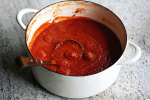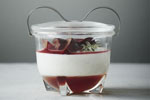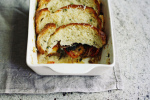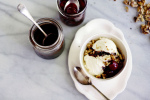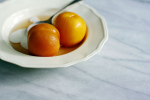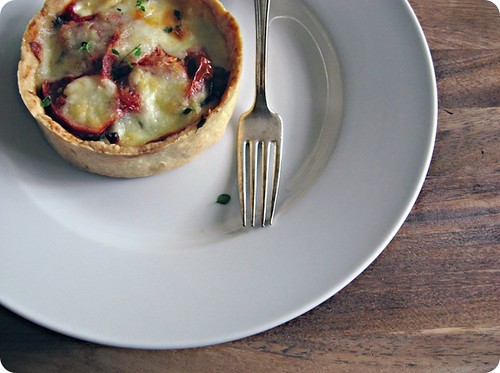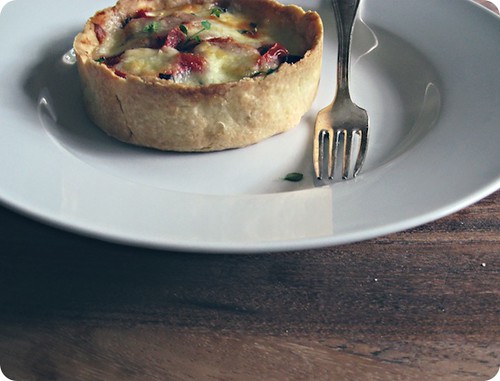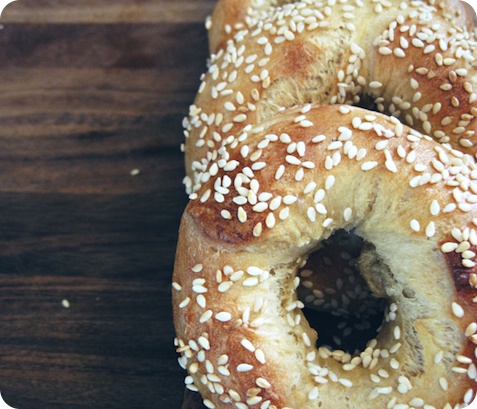Bespoke the quick arrival
 Saturday, August 29, 2009 at 10:26AM
Saturday, August 29, 2009 at 10:26AM I know that I am a bit early for our usual Thursday chat, but I made this tart last night and liked it so much that I couldn't wait five whole days to tell you about it.
As with so many happy accidents, I came about this success without paying much attention. It is the improvised partnership of recipes from others I admire, brought together by the downright-unglamorous need to clean out the fridge on Friday night before Saturday's trip to the market.
Heidi's Lasagna Tart was an instant favourite in our kitchen, first made within days of her kindly sharing the recipe. The barely-cooked sauce and the raw zucchini keep the flavour remarkably fresh and light even after baking, while the ricotta layer brings creamy relief to all that acidity. I have used the olive oil crust she provided, as well as the Parmesan variation she suggests. Both to great acclaim.
I had never made Rachel's Tomato and Zucchini Tart before, but is a recipe that piqued my interest. Instead of sauce hers has tomato slices, roasted briefly along with the summer squash to concentrate and sweeten their flavours. And her cobblestoned topping of fresh mozzarella is far from a bad thing.
Since yesterday brought rain and temperatures that bespoke the quick arrival of fall, I chose to take elements from each. I wanted a dish that brought some comfort, but didn't ignore that fact that it is still August. What follows is what I think I did, written without formality and with only my best estimates of quantities and timing.
I had not intended this tart as anything greater than our evening's meal. And so, to be safe, let me emphasize the essential parts of my hastily-scribbled instructions; sticky caramelized onions line a butter-laden crust, profoundly rich and yet well-matched by a smear of sharp, young cheese. Atop that are tiles of eggplant, zucchini and tomatoes, softening into each other, lush with their juices.
The final effect is one of substance without brawn, something so good that I had to share.
Happy weekend.
Late Summer Vegetable Tart
My adaptation of recipes from Rachel and Heidi, with thanks. The amounts and particulars below for the filling are a non-specific guideline. I was working with what we had on hand, but feel free to make omissions and substitutions to best suit your tastes (and contents of your fridge).
Ingredients
1 medium eggplant, cut into 1/4-inch slices
1 medium zucchini, cut into 1/4-inch slices
1 large onion, sliced thinly
2 shallots, sliced thinly
2 cloves garlic, minced
2 tablespoon white balsamic vinegar
1 teaspoon fresh thyme leaves picked from their stems, plus more for garnish
2 beefsteak tomatoes, cut into 1/4-inch slices, I used a mix of varieties and sizes
4 ounces herbed unripened goat's cheese
Parmesan cheese (an ounce or so)
Fresh mozzarella (around 1/2 a large ball)
Good quality olive oil
Kosher salt and freshly-ground black pepper
1 9-inch pastry shell of your choice, partially baked (see note)
Preheat oven to 425°F (220°C).
Take the eggplant and zucchini slices and toss in a large bowl with a generous sprinkling of salt. Transfer the slices to a colander and leave to drain.
In a medium skillet over medium-low heat, cook the onions and shallots in bit of olive oil, stirring occasionally. After about 20 minutes, or when the onions and shallots are lightly-caramelized and starting to catch in places, add the garlic. Cook for about 3 minutes more, so that the garlic has chance to mellow and soften. Pour in the vinegar to deglaze the pan, scraping and the bottom of the skillet with your spoon to pick up any brown bits. Cook for a minute or so, until most of the vinegar has evaporated. Remove the vegetables from the heat and stir in the thyme. Set aside.
Pat dry the eggplant and zucchini on a (non-terrycloth) kitchen towel. Coat the eggplant, zucchini and tomatoes in olive oil lay them out in a single layer on baking sheets. Season all with pepper, the tomatoes with salt too. Roast vegetables in the preheated oven, working in batches, until the vegetables are just beginning to brown in spots, around 20 minutes. Although the tomatoes were too delicate for such a procedure, I flipped the eggplant and zucchini over halfway through roasting. You want them tender, but not falling apart.
When the vegetables are done, remove from the oven and turn down the temperature to 350°F (175°C).
Beat the goat's cheese in a small bowl, with a drizzle of olive oil if needed, until creamy. With an offset spatula, spread the cheese over the parbaked pastry crust. Layer in the caramelized onions, then the eggplant, next the zucchini, and finally the tomatoes. Tear the fresh mozzarella into rough chunks over all. Using a vegetable peeler, shave a few large, thin shards of Parmesan on top.
Bake in the preheated over for 30 minutes, until the cheese is melted and beginning to brown. Allow to cool for a few minutes before serving, with a sprinkling of fresh thyme leaves to finish.
Makes 1 9-inch tart.
Notes:
• Yesterday I used an all-butter pâte brisée from Martha Stewart, making the full recipe and sending a second tart off to loved ones. I did make one change, using 1 tablespoon of vinegar (in this case white balsamic, usually apple cider vinegar) in place of an equal amount of ice water. I also make this crust with 1/2 cup of whole wheat flour instead of using all white.
• This was especially good the next day, gently warmed and served with a soft-yolked fried egg for brunch.
 aubergines,
aubergines,  eggplant,
eggplant,  main course,
main course,  recipe,
recipe,  summer,
summer,  summer squash,
summer squash,  tart,
tart,  tomatoes,
tomatoes,  vegetarian,
vegetarian,  zucchini
zucchini 


